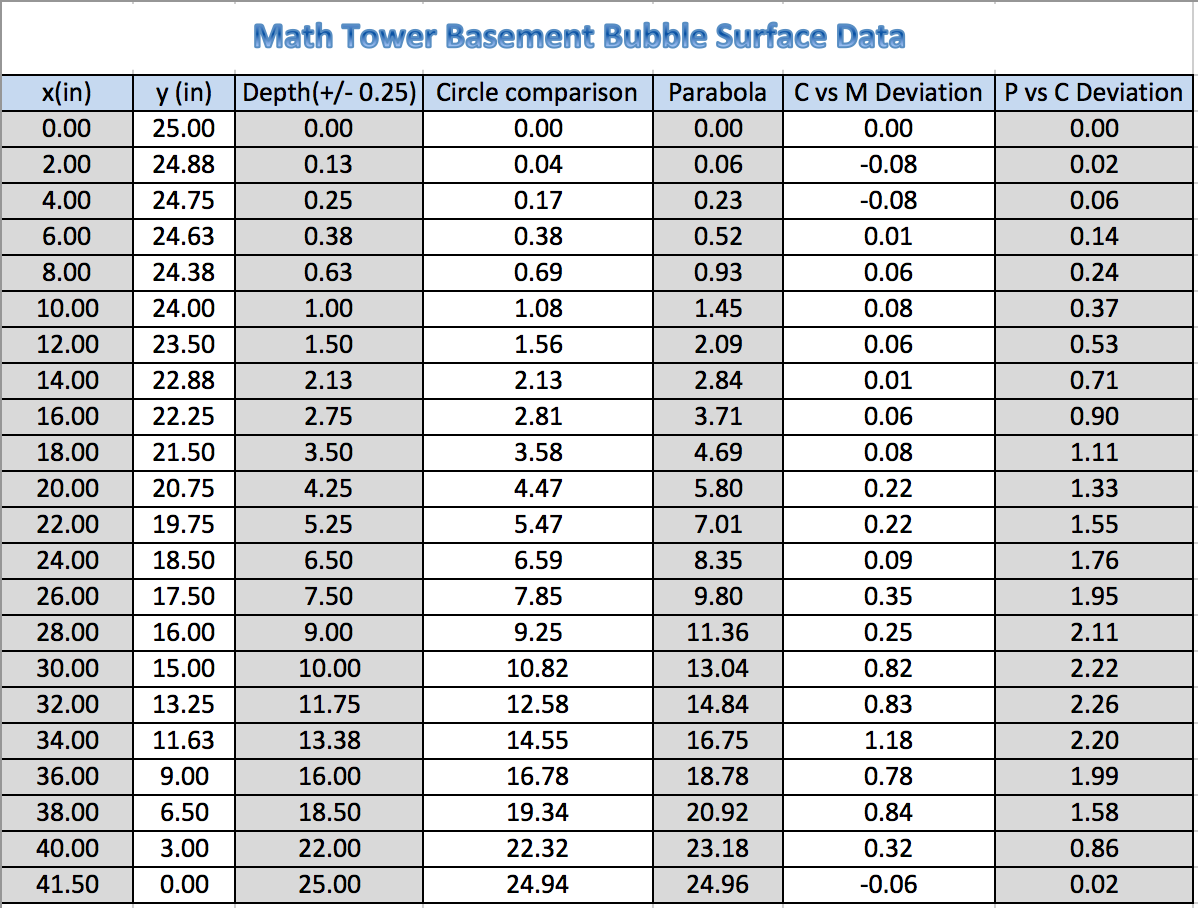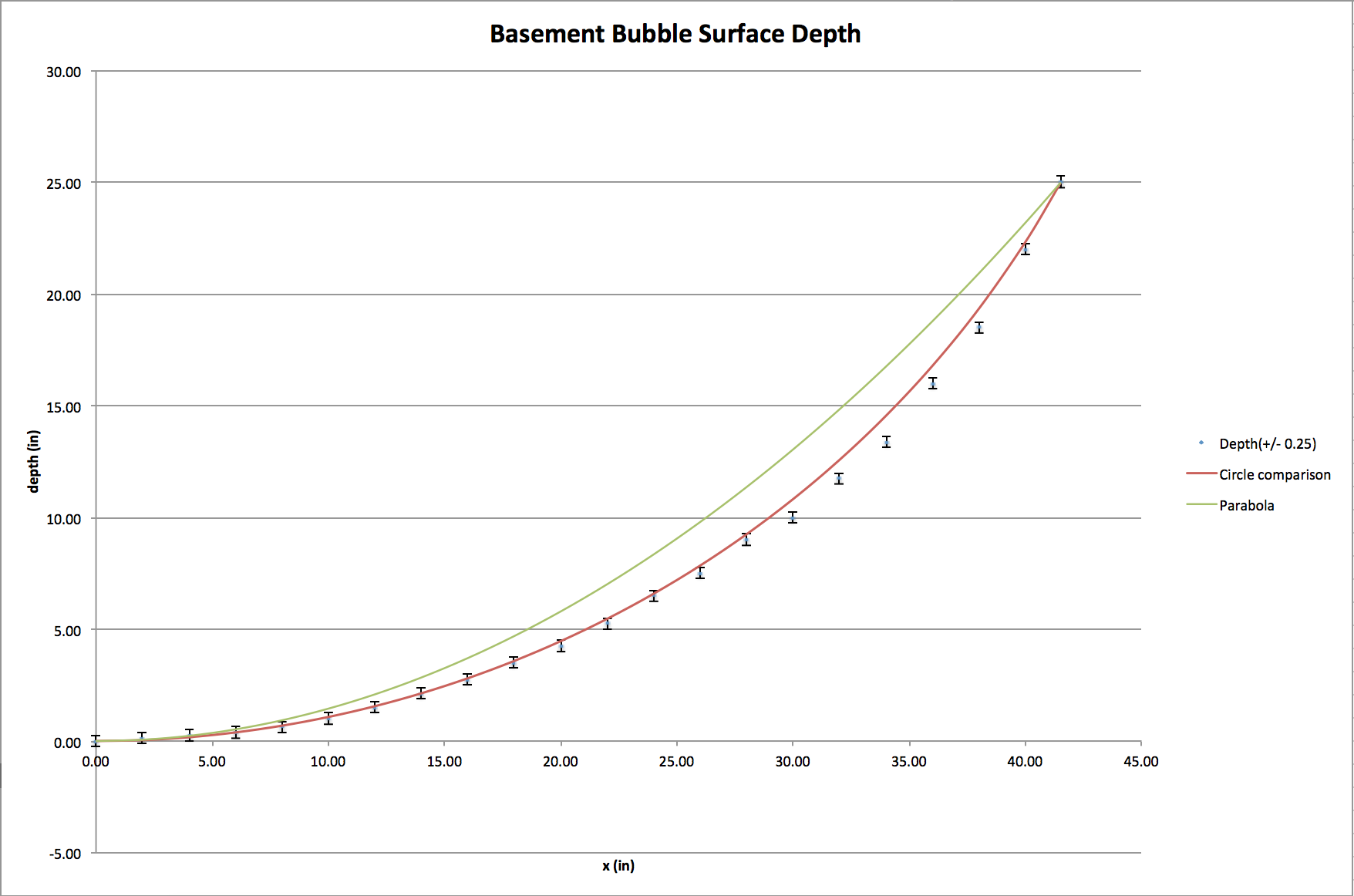Math Tower Basement Bubble Optics
Brandon Yalin, Jay Rutledge, John Noé, Max Stanley
Laser
Teaching Center,
Stony Brook University
The “Bubble” is a large, concave plastic mirror situated in a wall of the math tower basement that reflects both light and sound. In this experiment we are comparing depth measurements of the bubble surface to the curves of a circle and parabola to find its true shape. We are analyzing a circle, parabola, and ellipse to illustrate ray behavior and outline the advantage of each reflecting surface.
The bubble was installed during the construction of the math tower in 1974. According to professor emeritus Peter B. Kahn whom I had the chance to speak to personally, the bubble was built using a plastic molding. The purpose of the structure is to engage passerby's in a unique experience where they may see for themselves the reflective effects of concave surfaces.
To map the surface of the sphere we used two pieces of string that spanned the total diameter of the outer bubble. By using this method, we can create a point of origin for depth measurements along a perpendicular line taped to the inside surface of the bubble.

The bubble has three potential characteristics to define its surface, either being parabolic, elliptical, or spherical. Using a chord drawn across the diameter of the bubble, we were able to measure its length as well as the depth of the bubble relative to this chord. By placing the origin at the lowest depth within the bubble, we used the measurements of half the chord length and the depth to specify three points in which the surface must satisfy regardless of its shape. We measured the chord length to be 83 inches across, thus half a chord length is equal to 41.5 inches. This forms the points (-41.5,25),(0,0), and (41.5,25). If we assume the surface to be a sphere, using the sagitta method leads to the conclusion that the center of the circle is located 47 inches away from the farthest depth of the bubble. With this information, an equation for a circle was found and is portrayed as the red curve in the graph below. Using the measured points within this coordinate system, the parameter for the parabolic curve was calculated to be 0.014493. The curve is represented as the black curve in the graph below. As for the ellipse, there actually exists an entire family of curves that satisfy the points required to define the surface points while maintaing the major axis of the ellipse along the y-axis. These sets of curves however follow paths that exist in the space between a circle and parabola where each curve has different positions for its foci along the y-axis. As a result of this issue, we experimentally compare measurements along the curves of a parabola and circle for they feature the most concrete equations and specify the "bounds" in which an ellipse would find itself between.

Below is a graph of the depth difference between the equations for the parabola and circle along our domain in question. The largest deviation of depth is found at approximately 32 inches away from the y-axis featuring a maximum deviation of approximately 2.25 inches. Thus, depth measurements along these x-values will shed the most light on the true characteristic of the bubble surface.


Using a tape measure, we found the depth values at x-intervals of 2 inches and plotted our data along the curves of our calculated parabola and circle. We assumed an error of 0.25 inches within our measurements. Below is a graph of our data that features the surface depth measurements alongside our two calculated curves.

According to our measurements, the bubble surface most closely resembles our equation for the circle. The significant feature of this graph is the clear difference along the domain of greatest deviation between the circle and parabola. The measured points lay heavily to within error along the circle, even featuring points that exceed the depth of a perfect circle. This strange dip in values at approximately 35 inches away from the y-axis may be attributed to either measuring error or imperfections along the surface of the bubble due to warping or other wear throughout the years since its construction.

Above is the deviation between our measured points and our equation of the circle. The largest deviation is 1.18 inches +/- 0.25 inches at a distance of 34 inches away from the y-axis.
To the untrained eye at this scale, our surface can appear to be either shape described previously. Each concave surface however has significant differences in their features. From an engineering standpoint, each of these surfaces has their own interesting characteristics which may be favorable in different regards for its purpose of being an interactive structure.

For a parabolic surface, incoming parallel rays of either light or sound reflect off of the surface as depicted in the Mathematica demonstration above and focus to a single point that can be calculated using the parabolas directrix. If the surface of the bubble were parabolic, it would have featured a focus at the point (0,21.5) within our coordinate system. A parabolic surface would be best for focusing sound from a very far distance way or projecting sound/light outwards to infinity when using a ray source at the focal point. In history, parabolic mirrors were used to illuminate rooms using candles, where a light source held at the focal point can send rays of light to each point along the surface of the parabola and have light projected outwards. Solar reflectors use this property extensively when concentrating light to a component of some solar systems known as a receiver, where this light is used to heat a liquid for use in a steam turbine.

If the bubble were an ellipse, the focusing ability from incoming parallel rays of light would be rather different compared to a parabolic surface. First to note, an ellipse would not focus rays to a single point, but would rather feature a region of relative focusing, forming aberrations as seen in in the figure above. An ellipse as the interesting property of reflecting rays from a point source held at one focus to the opposite foci. If this was used for the math bubble, two people could stand at the foci of the elliptic surface and test this property using the sounds of their voices. They would note the increase in sound amplitude relative to their partner's amplitude of speech. Several engineers throughout history have made use of this property in creating what are known as whispering galleries. Within this structure, two people can stand at the foci of the elliptic structure and hear each other's whispers. St. Paul's Cathedral in London, for example, features a whispering gallery.

Experimentally, we have arrived at the fact that the Math Tower bubble is indeed a spherical surface. As made apparent in the diagram, a spherical surface does not feature a single focusing point but rather a general region of focus with incoming parallel light. A point source held at the center of the circle, where is this case is located 47 inches away, reflects rays off of the surface perpendicularly and focus back to the source. A person can see this effect at a distance of 47 inches away for themselves by speaking into the bubble from a farther distance and walking towards the bubble until the apparent amplitude of their voice increases to maximum amplitude. The reflective aberrations are far more pronounced within a spherical surface as compared to the two previous surfaces, which can explain several strange images that can be produced using a spherical mirror.

For example, in the image above the candle is held close enough to the surface of bubble to form an upright virtual image while still creating an outer ring. If we look to the ray trace model of the sphere displayed earlier, it is noted that there comes a point where incoming rays of light reflect perfectly perpendicular to the surface of the sphere and then at farther distances away from the y-axis begin to reflect at larger angles. The angle of light when reflected off of a spherical surface can focus to a point but only at these discrete ray distances relative to the central axis that form these angles, thus creating the observed ring. The ring can be formed at several different distances away from the surface of the bubble both from behind and in front of the focal point and be viewed from varying distances away from the bubble.


Here we see the largest fill of light across the surface of the sphere as the candle is moved closer to the focal point of the sphere geometrically located at approximately half of the radius away. Due to this angle issue as described with the ring pattern, as the light source is moved towards the focal point, the small changes in angle of reflection at distances close to the y-axis result in a region of the surface of the sphere that will reflect light to a single point. If we look back at the deviation graph described earlier, a parabola and a circle are relatively similar in shape at distances close to the central axis. The two surfaces behave similarly at these distances thus sharing similar points of focusing for incident angles close to the central axis. The key difference here is that if the surface of the bubble was parabolic and the light source was held at the same distance away, the entire surface of the parabola would fill with light.